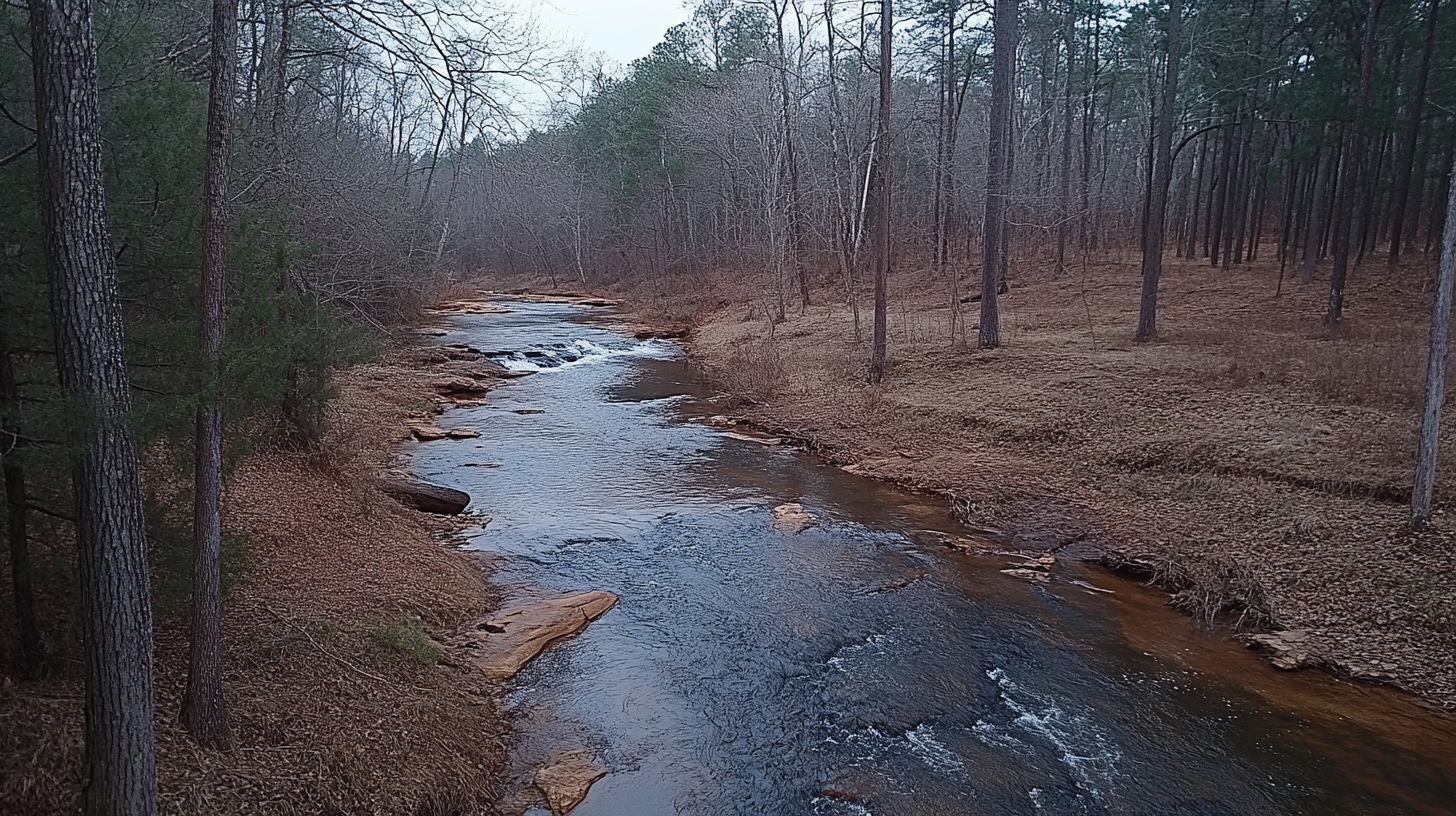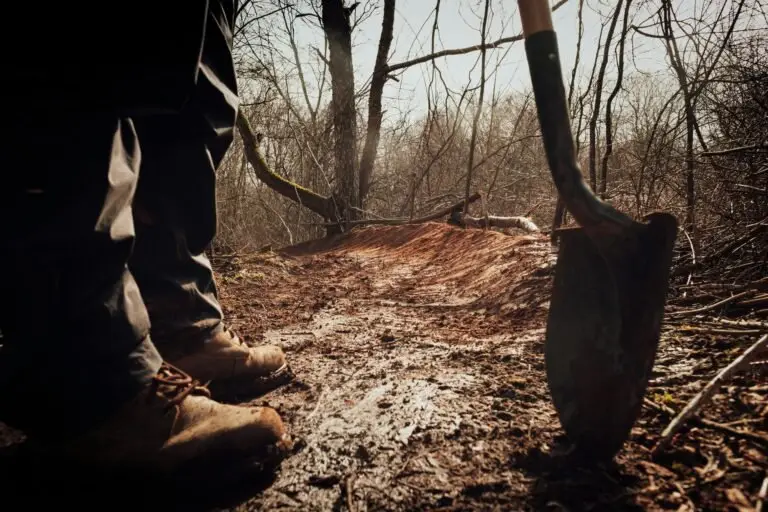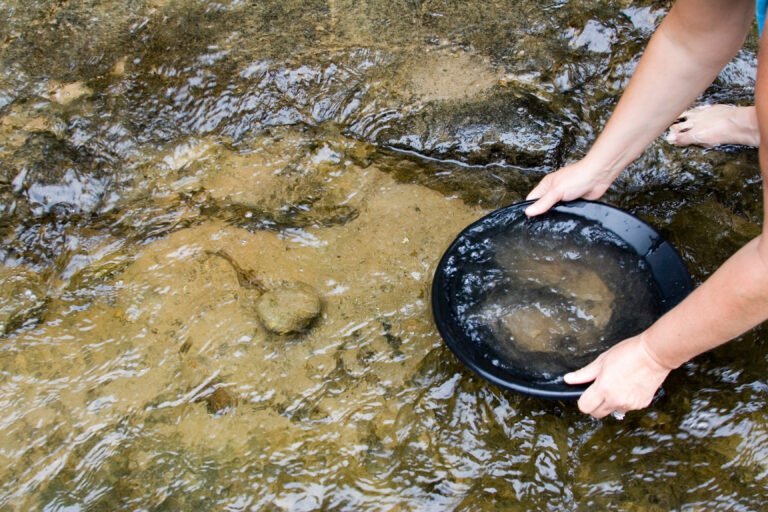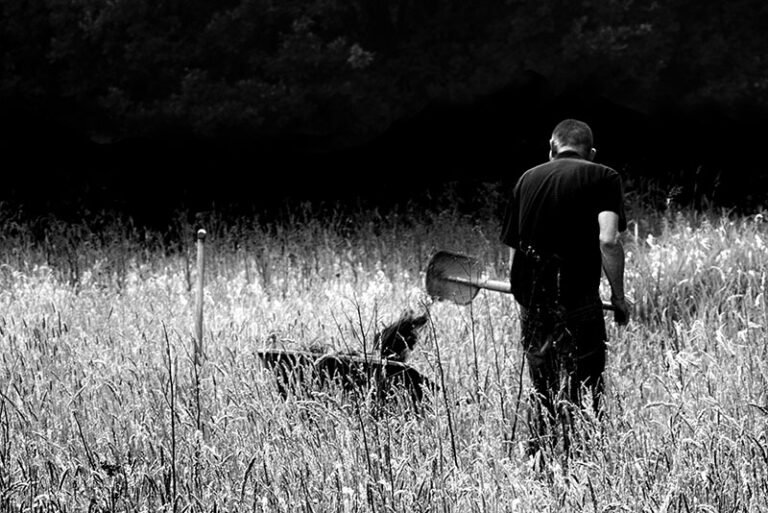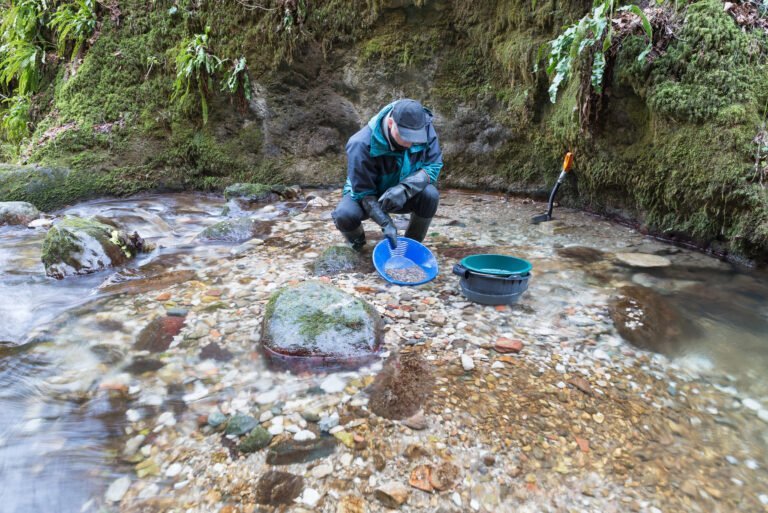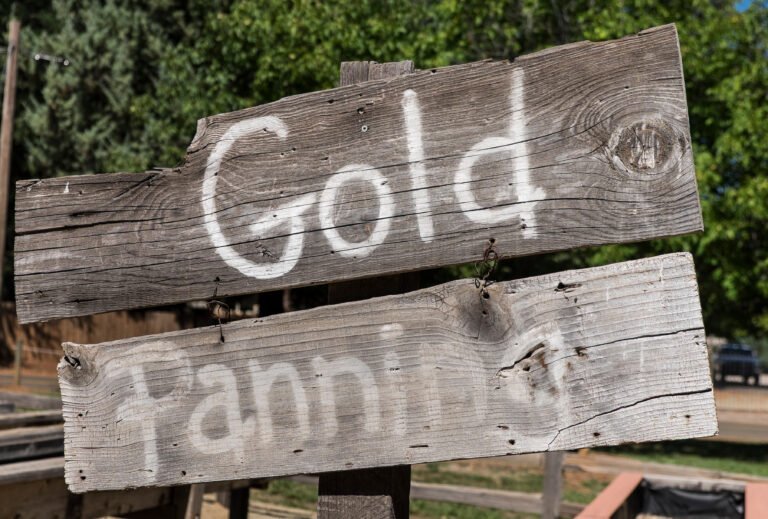When prospecting for gold in a creek, it’s important to know what signs to look out for.
These signs can help you identify potential gold deposits and increase your chances of striking gold.
So, let’s dive in and explore the indicators that can lead you to gold in a creek.
One of the key signs to look for is changes in water flow.
Gold is heavier than most surrounding materials, so it tends to settle where water flow slows down.
Pay attention to areas where the water current changes direction or where there are obstructions like rocks or logs.
Another important sign is the presence of certain minerals. Gold often coexists with other minerals like pyrite, quartz, and garnets.
Keep an eye out for these minerals in the creek bed or along its banks.
Changes in the surrounding rocks and soil can also indicate the presence of gold.
Look for areas where different types of rocks meet, as gold deposits are often found at these intersections.
Additionally, soil color changes can be a valuable clue.
Darker or richer-colored soil may indicate the presence of gold.
By paying attention to these signs, you can improve your chances of finding gold in a creek.
Now, let’s explore further tips and techniques for creek gold prospecting.
Key Takeaways:
- Changes in water flow can indicate potential gold deposits in a creek.
- Look for the presence of minerals like pyrite, quartz, and garnets that often accompany gold.
- Changes in surrounding rocks and soil, as well as soil color changes, can also be signs of gold.
- Paying attention to these signs can increase your chances of finding gold in a creek.
Prospecting Rivers, Creeks, & Streams
When it comes to finding gold, rivers, creeks, and streams are prime locations for prospecting.
These bodies of water provide excellent opportunities for gold panning in a creek, gold prospecting in rivers, and creek gold exploration.
To enhance your chances of success, here are some tips to keep in mind:
- Look for areas with varying water flow: In rivers, creeks, and streams, you’ll want to target areas where the water flow changes between fast and slow. These transitions create ideal conditions for gold to settle and accumulate.
- Focus on bends and obstacles: Bends in the river and areas where the water flow is altered by obstacles like boulders, logs, or changes in watercourse contours can be hotspots for gold deposits. These natural features disrupt the flow and provide the perfect environment for gold to be deposited.
- Pay attention to signs of gold: While panning for gold, keep an eye out for signs that indicate the presence of this precious metal. Look for black sands, which often contain small particles of gold. Other indicators can include the presence of pyrite, quartz, and garnets, which are commonly associated with gold deposits.
By honing your skills in prospecting rivers, creeks, and streams, you’ll increase your chances of uncovering beautiful gold nuggets and flakes.
Remember, patience and persistence are key in this exciting pursuit!
Desert Prospecting
In desert environments, prospectors can uncover the hidden treasures of gold in dry washes and alluvial areas.
The arid landscapes hold the promise of ancient rivers that once flowed, leaving behind gold deposits for the keen-eyed explorer.
To embark on a successful desert gold prospecting adventure, it is crucial to understand the key indicators that may lead you to the gold-rich areas.
One important clue to look for is evidence of a slowing down of water current.
This can manifest in the form of depressions or fissures in the bedrock, indicating the path of a former river or stream.
These topographical features can act as natural traps for gold, allowing it to settle and accumulate over time.
Dried up riverbeds and desert washes are also prime locations to search for gold.
These ancient channels, now devoid of water, may still bear the traces of their golden past.
The natural erosion and sedimentation processes concentrate gold in these washed-out areas, making them potential hotspots for gold prospecting.
However, it’s important to note that water is still essential for gold prospecting in the desert.
A source of running water is necessary for panning and processing the material collected during your exploration.
This could include bringing in water from an outside source or identifying nearby water sources that can be utilized for your prospecting activities.
To guide you further in your desert prospecting journey, consult the table below for additional tips and considerations:
| Desert Prospecting Tips |
|---|
| 1. Research the geological history of the area to identify potential gold-bearing formations. |
| 2. Use metal detectors or other advanced tools to aid in your search for hidden gold. |
| 3. Pay attention to changes in soil color and texture, which can indicate the presence of gold. |
| 4. Explore areas near known gold mines or historical mining districts as they may harbor unexplored gold deposits. |
| 5. Be prepared for the challenges of desert environments, such as extreme temperatures and limited water resources. |
The vast desert landscapes hold the secrets of gold waiting to be discovered.
With patience, persistence, and a keen eye for the signs, you can unlock the potential of dry wash gold prospecting and unearth the treasures hidden beneath the desert sands.
Beach Prospecting
Beaches are not just great for sunbathing and swimming – they can also be a treasure trove for gold prospectors.
Coastal areas where streams or rivers meet the beach can be especially promising for finding gold.
When beach prospecting, keep an eye out for two key indicators: black sand and bluish-gray layers of sand.
These characteristics often suggest the presence of gold deposits.
Surface gold on beaches is typically found about four feet below the surface, so be prepared to dig a little.
To make your beach prospecting adventures more efficient, consider using tools like the Gold Rush Nugget Bucket.
This innovative device is designed specifically for beach gold panning and can help streamline the process.
| Benefits of Beach Prospecting |
|---|
| Access to gold deposits carried by rivers and streams |
| Opportunity to find gold on the surface or just a few feet below |
| Potential for larger gold nuggets due to the erosion process |
| Beautiful beach scenery and enjoyable prospecting experience |
Prospecting for gold on beaches can be a rewarding and enjoyable experience.
Don’t overlook these coastal locations in your search for gold. With the right tools and a keen eye, you might just strike it rich!
Signs of Past Placer Mining
One effective way to find gold in a creek is to look for signs of past placer mining.
These signs serve as indicators that previous miners have found gold in the area and suggest that gold deposits may still be present.
Indicators of Gold Mining
When exploring a creek for gold, keep an eye out for the following signs of past prospecting:
- Ground cuts: Areas where the ground has been excavated or dug up. These cuts were made by miners searching for gold-rich gravel.
- Stacked rocks: Piles of rocks that could indicate the presence of old mining structures or tailings.
- Piles of rocks: Accumulations of rocks left behind by miners after extracting gold-bearing gravel.
- Stripped areas of ground cover: Places where the vegetation has been cleared or removed by previous mining activities.
- Ponds and dams: Water features created by miners for washing or sluicing gold-bearing material.
- Dry wash piles: Mounds of gravel that were processed by dry washing, a method used to separate gold from lighter material using air and vibration.
By identifying these signs of past placer mining, you can narrow down your search and focus on areas that have already yielded gold.
However, it’s important to note that the absence of these signs does not necessarily mean there is no gold present.
Always keep an open mind and explore different areas within the creek.
“The presence of ground cuts, stacked rocks, and stripped ground cover in a creek are strong signs that the area has been mined for gold in the past. These indicators suggest that the creek may still hold valuable gold deposits waiting to be discovered by today’s prospectors.” – Gold Prospecting Expert
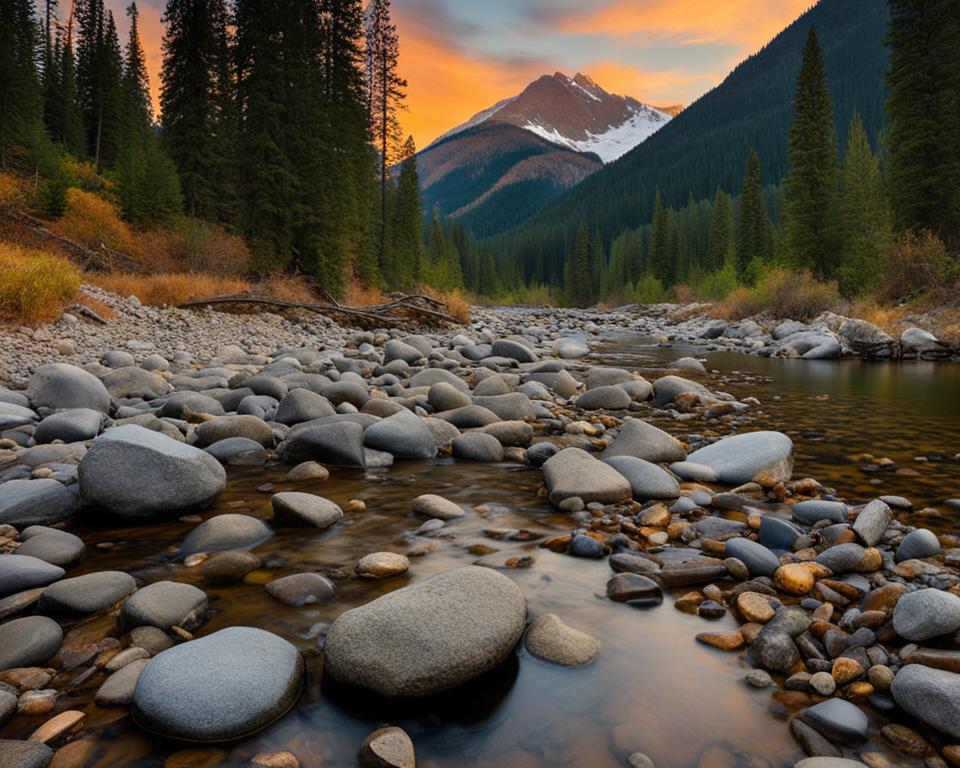
Disclosure: This Post Contains Affiliate Links; We earn a commission on purchases.
| Indicator | Description |
|---|---|
| Ground cuts | Excavated areas in the ground created by miners searching for gold-rich gravel. |
| Stacked rocks | Piles of rocks that may indicate the presence of old mining structures or tailings. |
| Piles of rocks | Accumulations of rocks left behind by miners after extracting gold-bearing gravel. |
| Stripped areas of ground cover | Places where vegetation has been cleared or removed by previous mining activities. |
| Ponds and dams | Water features created by miners for washing or sluicing gold-bearing material. |
| Dry wash piles | Mounds of gravel processed by dry washing, a method used to separate gold from lighter material. |
Past Hard Rock Mining Signs
Hard rock mining leaves behind distinctive signs that can indicate the presence of gold.
By understanding and recognizing these indicators, prospectors can enhance their chances of finding gold-bearing veins. Here are some key signs to look out for:
- Mining Dumps: Mining dumps, also known as mine tailings, are mounds of mineral-rich rocks and debris discarded during the extraction process. These dumps can contain traces of gold and serve as a valuable clue for prospectors.
- Open Stopes: Open stopes are excavated areas in rock formations created by underground mining. They often expose mineralized veins and can indicate the presence of gold deposits.
- Mill Tailings: Mill tailings are the fine waste materials left over after the crushing and processing of ore. These tailings can contain valuable minerals, including gold, and are often found near old milling facilities.
- Sulfides or Iron Oxides in Mine Dumps: The presence of sulfides or iron oxides in mine dumps can indicate the potential for gold-bearing veins. These minerals often accompany gold deposits and provide important clues for prospectors.
- Roads Leading to Old Mines: Roads that lead to abandoned or historical mining sites can be a strong indicator of past hard rock mining activity. These roads were often built to facilitate transportation of minerals, including gold.
It’s important to exercise caution when exploring old mine workings and avoid entering unsafe areas.
Be aware of potential hazards such as cave-ins, unstable structures, and toxic substances.
Always prioritize your safety and follow proper guidelines for mine exploration.
Here is an image showcasing some of the signs of past hard rock mining:
“Understanding the signs left behind by past hard rock mining operations can greatly aid in the search for gold-bearing veins.”
Rock-type Changes
One of the geology indicators of gold in a creek is changes in rock types.
Gold deposits are often found in areas where different geology types come together, creating favorable conditions for the formation of gold-bearing rock formations.
Prospectors should carefully observe the rocks in the creek and look for noticeable changes in rock types.
For example, the presence of quartz veins, sulfide mineralization, or alterations in the mineral composition can be indicators of potential gold deposits.
Vegetation Clues
Changes in vegetation can also provide valuable clues about the presence of gold.
Different plants and shrubs may prefer specific host rocks that are associated with gold-bearing formations.
By understanding the plant species and their preferences, prospectors can narrow down their search areas and focus on regions where gold is more likely to be found.
For example, certain plants like ironwood or sagebrush may indicate the presence of gold-bearing rock formations.
Paying attention to the types of vegetation can help prospectors in their search for gold in the creek.
Soil Colour Changes
When it comes to gold prospecting, paying attention to changes in soil colour can provide valuable insights.
Gold pieces are often found in soil that consists of small particles of rock and mineral.
By observing the soil colour, particularly when it becomes darker or richer in color, you can increase your chances of finding gold in that specific area.
Gold-bearing soil tends to exhibit distinct colour changes due to the presence of minerals and other geological factors. These changes can be indicators of potential gold deposits.
Darker soil, for example, may indicate the presence of iron oxides, which are often associated with gold-bearing soil.
Reddish or brownish soil may suggest the presence of copper minerals, which can also be a sign of gold.
Another valuable soil indicator of gold is the presence of black sands.
Black sands are a mix of heavy minerals, including gold, that have a dark color. They are often found in certain areas with high concentrations of gold.
When prospecting for gold, be sure to examine the soil closely and take note of any significant changes in color.
These changes can help you narrow down potential gold-rich areas and guide your prospecting efforts.
Signs of Gold-Bearing Soil:
- Darker or richer soil colour
- Presence of black sands
- Reddish or brownish soil
“By observing soil colour changes, prospectors can identify potential areas with gold-bearing soil and increase their chances of finding gold.”
FAQ
Q: What are some signs of gold in a creek?
A: Signs of gold in a creek can include changes in water flow, the presence of black sands, pyrite, quartz, and garnets, as well as alterations in the surrounding rocks and soil.
Q: How can I prospect for gold in rivers, creeks, and streams?
A: Look for areas with both fast and slow-moving water, bends in the river, and areas where water flow is altered by obstacles like boulders and logs. These are potential hotspots for gold deposits.
Q: Where can I find gold in desert environments?
A: Gold can be found in dry washes, alluvial areas, and dried up riverbeds. Look for areas where there is evidence of a slowing down of water current, such as depressions or fissures in bedrock.
Q: Can I find gold on beaches?
A: Yes, beaches can be fruitful for gold prospecting, especially where streams or rivers drain onto the beach. Look for black sand and bluish-gray layers of sand, as these can indicate the presence of gold.
Q: How can signs of past placer mining help me find gold?
A: Ground cuts, stacked rocks, piles of rocks, stripped areas, and other signs of past mining can indicate that gold deposits may be present in the area.
Q: What are signs of past hard rock mining?
A: Signs of past hard rock mining include mining dumps, open stopes, mill tailings, sulfides or iron oxides in mine dumps, and roads leading to old mines, which can indicate the presence of gold.
Q: How can changes in rock types help me find gold?
A: Gold deposits are often found where different geology types come together. Look for areas where there is a noticeable change in rock types as this can indicate the presence of gold.
Q: Can changes in soil colour be a sign of gold?
A: Yes, changes in soil colour, particularly where it becomes darker or richer, can be a valuable sign of gold presence. Gold pieces are often found in soil that consists of small particles of rock and mineral.
Q: What should I keep in mind when prospecting for gold in a creek?
A: Pay attention to the signs mentioned above, exercise caution when exploring old mine workings, and use appropriate equipment and techniques for creek gold prospecting to increase your chances of finding gold.
Conclusion
Gold prospecting in a creek can be an exciting and rewarding endeavor for those who have the knowledge and skills to identify the signs of gold deposits.
By understanding the various indicators and learning to observe changes in water flow, rock and soil types, vegetation, and other key factors, you can significantly increase your chances of finding gold in a creek.
When exploring a creek for gold, it’s important to exercise caution, especially when encountering old mine workings.
Always prioritize safety and use appropriate equipment and techniques for creek gold prospecting.
Remember to respect the environment and obtain any necessary permits or permissions before embarking on your prospecting journey.
To maximize your chances of success, consider these essential gold prospecting tips: thoroughly research the area you plan to prospect, invest in quality prospecting tools such as gold pans and sluice boxes, and join local gold prospecting clubs or forums to gain valuable insights and knowledge from experienced prospectors.
With dedication, patience, and a keen eye for the signs of gold deposits, you can embark on a thrilling adventure and potentially uncover the precious yellow metal hiding in the depths of a creek.
References
- https://www.goldrushnuggetbucket.com/pages/where-to-prospect-for-gold
- https://www.icmj.com/magazine/article/twenty-five-gold-indicators-you-should-know-3031/
- https://www.prospectorspatch.com.au/5-signs-to-check-for-gold-pieces-in-rocks-our-prospecting-guide/

Meet Ryan Conlon, the passionate owner and driving force behind Pan for Treasure.
With an unwavering love for the art of gold panning, Ryan has transformed his enthusiasm into a thriving community hub for fellow treasure seekers. info@panfortreasure.com
A seasoned gold panning enthusiast, Ryan’s journey began with a simple pan and a dream, evolving into a deep appreciation for the history, geology, and thrill of uncovering precious metals.
Subscribe to Our Newsletter

